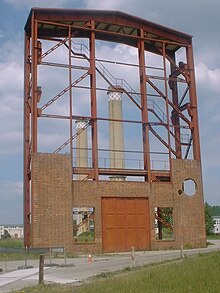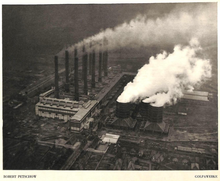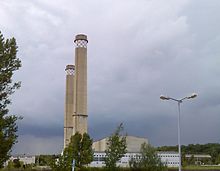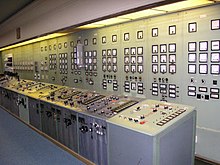Zschornewitz power plant
The Zschornewitz power plant was one of the oldest power plants in Germany and is now an industrial monument .
prehistory
In 1913 the Berliner Elektrizitäts-Werke (BEW) reached their capacity limits, which is why new electricity supply contracts had to be negotiated with the city of Berlin (there was no contract at the time). At that time, AEG was a leader in the field of electrical power generation and wanted to supply Berlin with long-distance electricity. As a result, a power plant with six steam turbines, each with an electrical output of 16 MW and 60 steam boilers with a heating surface of 450 m² each, was planned. The necessary brown coal should come from the Golpa - Jeßnitz opencast mining area (northeast of Bitterfeld). There were three drafts for the power plant location, which related to the supply of cooling water for the power plant.
On February 9, 1915, a contract was signed between the Bavarian nitrogen works Munich AG and the lignite works Golpa-Jeßnitz AG for the construction of a large power station. The power plant was also required to supply the Piesteritz nitrogen works with energy . The power plant should have 60 MW electrical output and deliver 500 million kWh annually. The engineer Georg Klingenberg carried out investigations for the power plant site and recommended the Zschornewitz district as an economic location.
Construction and commissioning
The groundbreaking ceremony for the construction of the power plant took place on March 24, 1915. On May 21, 1915, the lignite works Golpa-Jeßnitz AG was moved to Elektrowerke AG and its headquarters to Berlin.
In August 1915, AEG decided to double the power plant output. In November 1915 the first steam boilers were put under dry fire. At the beginning of December 1915, these could then be put into normal operation. The first steam turbine (machine 1) went into operation on December 15, 1915 and took over the power supply for the power plant construction. On December 24, 1915, the pipeline to the Piesteritz nitrogen works was put into operation on a trial basis. Finally, on January 2, 1916, final deliveries to the plant began. This meant that 8 steam turbines and 64 steam boilers were in operation in the Zschornewitz power plant.
Until May 1917, the "Golpa" lignite mine, which was part of the power plant, could not deliver the required amount of coal.
Extension buildings
In September 1917 negotiations were held between Elektrowerke AG and the budget committee of the Reichstag. The contract was signed on September 28th. As a result of this contract, Reichselektrowerke AG was created on October 1, 1917, and the Zschornewitz power plant was thus an indirect Reich company.
During the First World War , the demand for aluminum rose sharply in Germany. The production of aluminum is very energy-intensive and is carried out exclusively by fused- salt electrolysis of aluminum oxide . In July 1918, the first national high - voltage overhead line was completed from the Zschornewitz power plant to the aluminum plant on the Rummelsburger Bucht in Berlin. A second high-voltage overhead line followed in October 1918 to the Bitterfeld aluminum works .
Between 1924 and 1929 the Zschornewitz power plant was rationalized and modernized. The chain railway was replaced by large electric trains, pressurized water deashing of the steam boiler was installed and another long-distance line to Berlin was built.
In 1925/1926 the power plant was expanded to include a boiler house with six new steam boilers. For the first time, these steam boilers had automatic grates and a heating surface of 1000 m². The machine output was also increased by installing two turbines with 12.5 MW and one turbine with 35 MW electrical output.
Due to the increasing demand for electricity, the power plant output had to be increased further over the next few years. A further six steam boilers were installed in the newly built boiler house , which had been modernized again and where a hollow grate furnace was used. In order to install the 85 MW turbines, built by Brown, Boveri & Co. in Mannheim, (the largest in Europe in 1929) in the power station, it was necessary to build another nacelle. These turbines were put into operation in November and December 1929. The total output of the power plant at that time was 431.5 MW.
Dipl.-Ing. Since 1927, Krämer developed a coal mill which combined the grinding drying with wet lignite with the injection process; the beater mill came into being. In 1934 the development of mill firing was completed. In 1935, 16 outdated steam boilers were demolished in the power station and replaced by 10 steam boilers with mill firing according to Krämer with a capacity of 60 t / h steam. These steam boilers were put into operation until 1936. Further steam boilers were built between 1936 and 1938 (two with 60 t / h and four with 80 t / h).
In 1939 a ballast system was designed, incorporating the latest scientific findings. Four new steam boilers with a capacity of 200 t / h each, an operating pressure of 125 kg / cm² and a steam temperature of 500 ° C and four high-pressure turbines with a capacity of 20 MW each were planned for the power plant. On February 4, 1944, the first ballast was put into operation. By the end of the war, only two of the ballast systems could be put into operation and the total output of the power plant was 470 MW.
On April 20, 1945, the power plant was shelled by American artillery ; but there was no significant damage. The power plant operation was discontinued except for the self-supply. On April 25, 1945 the place and the power station were occupied by American troops. They handed both over to the Soviet troops on May 4, 1945 on the basis of the agreements of the Yalta Conference .
On May 5, 1945, the prerequisites were created to increase the power plant output according to the given possibilities.
In the summer of 1945, parts of the plant with a capacity of 295 MW were dismantled, which had to be given to the Soviet Union as reparations . That was 63% of the installed power plant capacity. Despite these measures, a capacity of 170 MW could be provided, which corresponds to about 10% of the electrical energy generated in the area of the later GDR.
Construction of supra-regional high-voltage lines
Power plants are usually built where the energy source (fuel, water power) or cooling water is cheaply available. With the electrical energy it is possible to supply more distant consumers through power lines.
Head to Piesteritz
As early as 1915 and 1916, the first long-distance line for 50 Hz electricity from the Zschornewitz power plant to the Piesteritz nitrogen plant was put into operation. A parallel pipeline conducted the 16-2 / 3-Hz current from the nearby Muldenstein railway power station to Piesteritz. The Piesteritz nitrogen plant was supposed to take over the supply of synthetically produced nitrogen fertilizers and explosives during the German naval blockade in World War I. For this reason, electrical operation in the central German rail network was discontinued when the war began in 1914.
Head to Berlin
From October 10, 1917 to July 6, 1918, a 110 kV high-voltage overhead line from the Zschornewitz power plant to Berlin was built with the participation of Siemens-Schuckertwerke to supply the aluminum plant on the Rummelsburger Búcht ( Golpa line ).
In the Lichtenrade area to the west of the Dresden Railway, this line reached what would later become the Berlin urban area ( Greater Berlin ). At the level of the industrial area at the Buckower Chaussee S-Bahn station (opened in 1946), the line swung to the east-north-east. The route can still be traced today using the so-called high-voltage route. The line then led through the Königsheide and then crossed the Spree. The line split up at Rummelsburger Chaussee. A branch was led to a substation located at the Rummelsburg power plant to supply the aluminum plant. The other branch of the high-voltage line led north to another substation near Friedrichsfelde . This line was extended west to the Moabit power plant until 1925 in order to create a network of power plants.
The aluminum plant was closed after the First World War. The Klingenberg power plant was built on this site between 1925 and 1927 .
The high-voltage line to Berlin hit the international headlines in 1948 when it was shut down during the Berlin blockade . After the end of the blockade in 1949, the supply to the western part of Berlin was not restarted, and the power grids were finally disconnected. Coming from Zschornewitz, the line was swiveled eastwards in front of the Berlin city limits. In the western part of Berlin, the Zschornewitz high-voltage line was dismantled in the 1950s.
With the start of coal production in the Golpa-Nord opencast mine in 1964, it was necessary to relocate the high-voltage lines to Berlin and Piesteritz. The former route and the remains of the foundations of the high-voltage lines can still be seen in some places today.
Line to Bitterfeld
Another pipeline was built from the Zschornewitz power plant to the Bitterfeld aluminum plant and put into operation in October 1918.
Modernization after 1945
In 1952/1953, project work for the expansion of the power plant was started as part of the five-year plan . A new upstream system with four steam boilers with reheating, two upstream turbines (25 MW output) and two downstream turbines (50 MW output) were to be installed. The project began in 1955.
In 1952, the first rapid repair method was carried out as part of a general repair of a turbine. The planned repair time was 36 days, with the quick repair method the repair was finished after 8.5 days.
January 1956 saw the start of construction on the second ballast. The first high-pressure boiler was put into operation on December 5, 1957 with a steam output of 160 t / h at 125 atmospheres and 500 ° C. The first upstream turbine with 25 MW was put into trial operation on January 29, 1958. The second upstream turbine went into trial operation on April 23, 1958. The commissioning of the second high-pressure boiler took place on May 29, 1958, with which the trial operation of the upstream system was completed.
The installation of the 50 MW back-up turbine began in the summer of 1961 and it went into continuous operation on November 13, 1961.
Between 1963 and 1965 the 110 kV switchgear “Neue Warte” was reconstructed.
From 1964, the power plant was also supplied with lignite from the newly developed Golpa-Nord opencast mine . The long-distance lines leading through this area to Berlin and Piesteritz were laid.
In 1970, the ballast was completed with the installation of a 20 MW turbine from the Buna chemical works . This went into continuous operation on October 31, 1970.
Conversion to natural gas operation
In the years 1970 to 1973 the power plant was partially converted to natural gas , during which the four steam boilers of the upstream switchgear were converted.
The power plant was expanded to include a gas turbine power plant with four gas turbines in 1970/1971. The factory was built next to the switch building of the "Neue Warte". The gas turbines (MS5000R) were built by the Alstom company . The gas turbines could run on natural gas or diesel fuel and generated 17 MW of electrical power. Construction began in April 1971 and the fourth turbine was put into operation on November 16, 1971.
The steam boilers in the ballast, which were equipped with natural gas burners, were converted back to coal-fired between 1976 and 1980.
From 1977 to 1979 a second gas turbine power plant was built on the site of the power plant. The six gas turbines with waste heat boiler (type G24) for this power plant are from Bergmann-Borsig . The gas turbine plant was available in March 1979 with an output of 192 MW. The total output of the Zschornewitz power plant had thus increased to 449 MW.
In 1983 a further 25 MW turbine was installed in the upstream switchgear of the steam power plant and completed it.
Between 1982 and 1984 the steam power plant's electrostatic precipitators were replaced.
The poor state of construction of the cooling towers made it necessary to build new ones. Between 1985 and 1988 four fan cooling towers were built .
A third gas turbine power plant was built from 1987 to 1988 next to gas turbine plant 1 ("Neue Warte"). Here again the company Alstom was the manufacturer. Four MS6000 gas turbines with an output of 37 MW were used in this power plant. In November 1987 the last turbine was connected to the grid, and the total output of the Zschornewitz power plant rose to 597 MW.
Shutdowns
On July 1, 1992, the last turbine in the steam power plant was shut down forever. The steam power plant was then dismantled by 1995 and part of it was converted into a museum. The heat supply for the places Zschornewitz and Graefenhainichen is ensured with the help of gas boilers. This heating plant was built on the site of the power plant and took over the supply shortly before the steam power plant was shut down.
On December 31, 1998, gas turbine power plants 1 to 3 were shut down. In March 1999 ( "New Wait") was dismantled a gas turbine (model MS5000) and after the gas turbine power plant 1 Sweden in a power plant in Uppsala brought. The gas turbine was rebuilt there and has served as an emergency power supply for the power plant since October 1999 . The four gas turbines (MS6000) of gas turbine power plant 3 were sold to Australia and built by employees of the then VEAG. Today, two of these gas turbines are located in Roma (Queensland) , one in Ipswich (Queensland) and the fourth in Somerton , a suburb of Melbourne in Victoria . The construction of the turbines in Australia took place in two stages between 1999 and 2001.
The two chimneys of the G24 gas turbine power plant were blown up on April 4, 2012. With that the penultimate landmark of the place Zschornewitz disappeared . The last, the listed cooling tower, was demolished in August 2015.
See also
- SKW Trostberg AG as the successor company of Bavarian nitrogen works Munich AG
Sources of information
- History books of the power plant
- Company newspaper of the power plant
- Broadcasting Bitterfeld-Wolfen (RBW)
Individual evidence
- ^ The electricity supply of Central Germany. A review of the new advertising film "The City of Sun" . In: HELIOS Export Trade Journals of Electricity and Radio, Leipzig and Vienna, Volume 31, No. 39 of September 27, 1925, pp. 6-7 - ( digitized version )
- ↑ Silva-Karte 1925 on: ZLB Berlin, accessed on May 16, 2020
- ↑ Ulf Rostalsky: Once the world's largest power plant in Zschornewitz. Cancellations in the anniversary year. In: Mitteldeutsche Zeitung. mz-web.de, August 13, 2015, accessed on August 27, 2015 .
Web links
Coordinates: 51 ° 43 ′ 6.7 ″ N , 12 ° 24 ′ 1.6 ″ E







